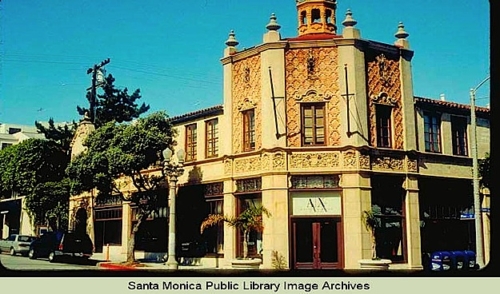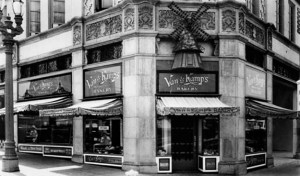Parkhurst Building

- Known As
- Spanish Colonial Revival
- Architect
- Marsh, Smith & Powell
- Built
- 1927
- Designated
- December 6, 1977
Spanish Colonial Revival architecture flowered in the 1920s and 30s to become the dominant regional style of Southern California. Of the thousands upon thousands of structures built in this mode however, only a small number were as attractively executed as the Parkhurst Building. Altered little since its construction, the Parkhurst remains an outstanding example of the style.
The Parkhurst Building was named for Clinton Gordon Parkhurst, the man who had it built. Parkhurst was a prominent realtor in the Santa Monica area and was active in the civic affairs of neighboring Venice. Indeed, before Venice ceded its independence to Los Angeles in 1925, Parkhurst had served as the city’s penultimate mayor.
Parkhurst engaged the well-known architectural firm of Marsh, Smith & Powell to design this building at the corner of Pier Avenue and Main Street. Norman F. Marsh, the best known partner in this firm, was considered by contemporaries to have created “some of the most beautiful and distinctive buildings in Southern California.” Indeed, Parkhurst may have known Marsh because Marsh had designed the City of Venice while in partnership with C.H. Russell. Considered a leading architect in the western United States during the period, Marsh completed many other commissions as well, including the University of Redlands and Hollywood High School. Herbert Powell and David Smith, Marsh’s partners when the Parkhurst Building was built, are less well known. However, they seem to have played active roles in its design. In fact, in recent years Powell has stated that he actually designed the Parkhurst Building while Smith did the necessary engineering.
Credit must go to all three for creating an exceptional building. While, at first glance, the Parkhurst seems to employ every Spanish-style device known to man, the overall effect is delightful rather than garish. Notable features include decorative ironwork above the first-floor storefronts and elsewhere, embellished panels showcasing motifs such as scallops, fish, stylized plants, and vases, a Moorish-style perforated screen on the Pier Avenue side, a tile mosaic featuring an equestrian theme (also on the Pier Avenue side), and the essential low-pitched, red tile roof. Perhaps the most striking aspect of the Parkhurst Building, however, is its multi-sided tower with exposed, patterned, brickwork. The tower is topped with a fanciful cupola and finials and completes the feeling that the building “might have come out of a Hollywood film on old Seville.”
Thanks to this plethora of wonderful details the Parkhurst Building not only merits its landmark designation, it is also listed on the National Register of Historic Places.
Sources:
- David Gebhard and Robert Winter. Los Angeles: An Architectural Guide. Salt Lake City: Gibbs-Smith Publisher, 1994.
- Cyril M. Harris. American Architecture: An Illustrated Encyclopedia. New York: W.W. Norton, 1998.
- Santa Monica Historical Resources Inventory, 1985-1986. City of Santa Monica, Building and Safety Department.
- Santa Monica Landmarks Tour. Santa Monica: City Planning Division, 2004.
- Staff Report on 185 Pier Avenue (2942 Main Street), Parkhurst Building. City Planning Division, Santa Monica.
